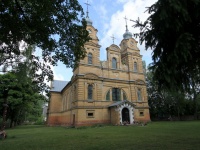- Home
- →
- Attractions
- →
- Church of God`s body in Dvorec
Church of God`s body in Dvorec
Dvorets Church of Corpus Christi is an outstanding Catholic church located in the village of Dvorets, Grodno Region. This majestic church in the Neo-Baroque style attracts attention not only with its refined architecture but also with its profound historical and cultural significance. Built in the early 20th century, the church is included in the State List of Historical and Cultural Values of the Republic of Belarus and is one of the main landmarks of the region. Its visit is often part of excursions around Belarus, with tours from Minsk being especially popular, allowing tourists to immerse themselves in the spiritual and architectural heritage of the country.
History of Creation
The history of the village of Dvorets dates back centuries. The first written mention of it refers to the early 15th century, and from 1451 the estate was owned by representatives of the noble Kezgailo family. As early as 1516, a Catholic parish was established in Dvorets, indicating the development of spiritual life in the local community. At that time, funded by Nikolai Kezgaila, the first wooden Church of Corpus Christi was built. In the 17th century, the church became famous for its miraculous icon of the Virgin Mary, which increased its significance as a religious center.
By the early 20th century, the wooden church had deteriorated, and in 1904, a new stone church was built in its place in the Neo-Baroque style. In 1905, it was consecrated and became an adornment of the area. However, the church's fate was difficult: after World War II, it was closed and desecrated, turned into a stable. Only in 1989 was the building returned to the Catholic Church, restoration was carried out, and in 1990 the church was re-consecrated. Today it is open to believers and tourists who visit it as part of excursions around Belarus.
Architecture and Spiritual Life
The architecture of Dvorets Church is a vivid example of the Neo-Baroque style with elements of Neo-Renaissance. The church is built as a three-nave basilica with two high towers topped by elegant domes. The central nave is covered with a gable roof, while the side naves have single-pitched roofs. The main facade of the church is richly decorated, with all decorative elements made exclusively of brick masonry without plaster, which gives the building a special authenticity.
The arched entrance framed by rusticated brickwork, as well as arched windows in the towers characteristic of Neo-Renaissance architecture, deserve special attention. Inside, the church is adorned with vaulted ceilings, and the zoned space creates an atmosphere of solemnity and comfort. The church grounds are enclosed by a fence with a beautiful brick gate (brama). Today, regular services, religious holidays, and rites are held here, attracting both parishioners and tourists. For many, visiting the church becomes part of a spiritual experience, especially if they arrive during excursions from Minsk or other regions.
Excursions with Church Tour
Dvorets Church of Corpus Christi is often included in the itineraries of excursions around Belarus, particularly those focused on the landmarks of the Grodno Region. Thanks to its unique architecture and rich history, it is popular among tourists interested in cultural heritage. As part of excursions from Minsk, visitors can not only explore the church but also learn fascinating facts about the Kezgailo family, the construction and restoration of the church, as well as the miraculous icon once housed here.
Everyone interested can book an excursion with a tour of the church and enjoy the atmosphere of the ancient temple, which has preserved its uniqueness and importance through the centuries. Professional guides share insights into the church's role in the life of the local community, its architectural features, and the revival of spiritual life after the church was returned to the Catholic faith. Visiting the church leaves a deep impression and allows each guest to feel the spirit of the past, preserved within the walls of this historical monument.

